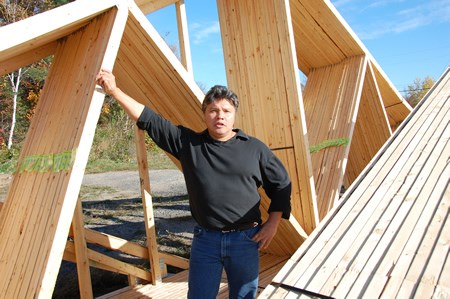A former sawmill property has gotten new life with a First Nation-owned and operated building component manufacturer.
Having started up in the fall of 2006, Garden River Truss Company makes wood roof trusses, open web floor joists, and pre-fab wall panels mainly for the residential housing market.
The company is the first tenant for the Garden River band which hopes to build out an eventual industrial park situated at the junction of former Highway 17 and the new bypass heading east to Sudbury. The six-acre property was once the site of a sawmill operation destroyed by fire 15 years ago.
Owned by the Garden River (First Nation) Development Corporation, the plant has been outfitted with a modern automated saws and assembly systems.
“We’re still pretty new in the market,” says Richard Perrault, sales rep and designer.
They opened their first year at the tailend of the building season, but they quickly expanded to a double shift when calls and orders came flowing in from builders looking to try out the new guys. This fall, with construction winding down, a single shift employs 12, all from the local First Nation.
Perrault designs open web and I-joist floors while estimator Matt Pine designs trusses for custom roofs.
Much of the product heads to Sudbury, where they now have a sales rep with another stationed in the Temagami area to cover the Highway 11 corridor from Timmins-Kirkland Lake to Bracebridge.
Some product has gone to Wawa and along the Lake Superior reserves and towns. They even deliver by truck as far north as Fort Albany where they sold 11 units last year.
“Our policy is to sell to the First Nations housing coordinators and their band members,” says Perrault. “If we get a call from Bear Island, Temagami looking for a house package, we give them a direct quote, otherwise it’s through the retail network of Home Depot and Home Hardware.”
The company exported across the St. Mary’s River last year to the Soo (Michigan) Tribe but that has tailed off because of the unfavourable currency exchange.
Production is measured by value in an eight-hour shift, says Perrault, which should be $10,000, or roughly enough trusses for seven or eight homes.
Garden River Truss has eyes to edge into northwestern Ontario toward Sioux Lookout, where builders source their material from Manitoba and Saskatchewan. He believes they can beat their competitors' six- to seven-week delivery window by delivering within five to seven business days from the time they take the order.
They have a fully-automated 16,000-square-foot shop with a high-speed Alpine linear saw making precise cuts on lumber provided by Tembec and Domtar. There’s also an 87-foot assembly table capable of handling multiple trusses at a time.
Perrault says they have the capability to expand into commercial projects and garage-shed packages but are content to take “baby steps” for now. The biggest truss they make spans 80 feet.
They also want to incorporate BluWood, a popular wood protection system used for trusses, I-joists and open web that protects wood from fungus and wood-destroying insects.
During the fall and winter, the plant usually reduces to a skeleton crew, but if they can land some sales in Sioux Lookout where 75 homes are being built, the company will be producing through the winter months.
“We’re still learning quite a bit yet to improve shop efficiency, getting orders and making sure we have inventory in stock,” says Perrault.




